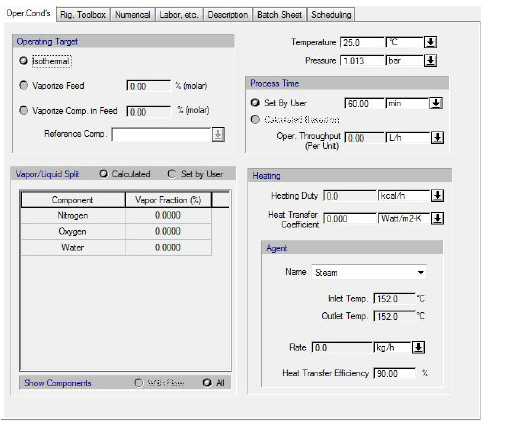

The following table shows a brief description of the variables appearing in this tab. The table also displays their default values and their generally acceptable range:
|
Variable |
Default Value |
Range |
|
|
||
|
○ Feed Vaporization (% mol) |
50.0 |
0 – 100 |
|
○ Component Vaporization (% mol) |
50.0 |
0 – 100 |
|
○ Ref. Comp. |
<None> |
Any Pure Component |
|
◙ Evaporation (%) |
0.0 |
0 – 100 |
|
○ Operating Temp. (C) |
25.0 |
Positive |
|
○ Operating Pressure (atm) |
1.0 |
Positive |
|
○ Heat Transfer Coefficient (kcal/h-m2-oC) |
2,500.0 |
Positive |
|
○ Agent Name |
<Steam> |
Any Heat Transfer Agent |
|
● Inlet Temp. (oC) |
152.0 |
Positive |
|
● Outlet Temp. (oC) |
152.0 |
Positive |
|
● Heating (kcal/h) |
0.0 |
Positive |
|
● Agent Rate (kg/h) |
0.0 |
Positive |
|
○ Heat Transfer Efficiency(%) |
90.0 |
[0,100) |
|
◙ Process Time (min) |
60.0 |
Positive |
|
● Operating Throughput (Per Unit) (m3/h) |
0.00 |
Positive |
Symbol Key: ○ User-specified value (always input); ● Calculated value (always output); ◙ Sometimes input, sometimes output
The following list describes the available specification choices in this tab; for more details on how these are implemented, see Thin Film Evaporation: Modeling Calculations.
The evaporation fractions can either be calculated with thermodynamic models or be set by the user. In the latter case the user needs to set the temperature. In both cases the user can specify if a component is volatile or not in the component table.
The following thermodynamic models are supported for the vapor phase:
● Ideal gas
● Van der Waals
● Redlich-Kwong
● Soave-Redlich-Kwong
● Peng-Robinson
The following thermodynamic models are supported for the liquid phase:
● Ideal mixture
● Soave-Redlich-Kwong
● Peng-Robinson
The process time controls appear only if the flowsheet and procedure are in batch mode. In Rating Mode, you can set the process time or allow the process time to be calculated based on the throughput. In Design mode, you must specify the process time.